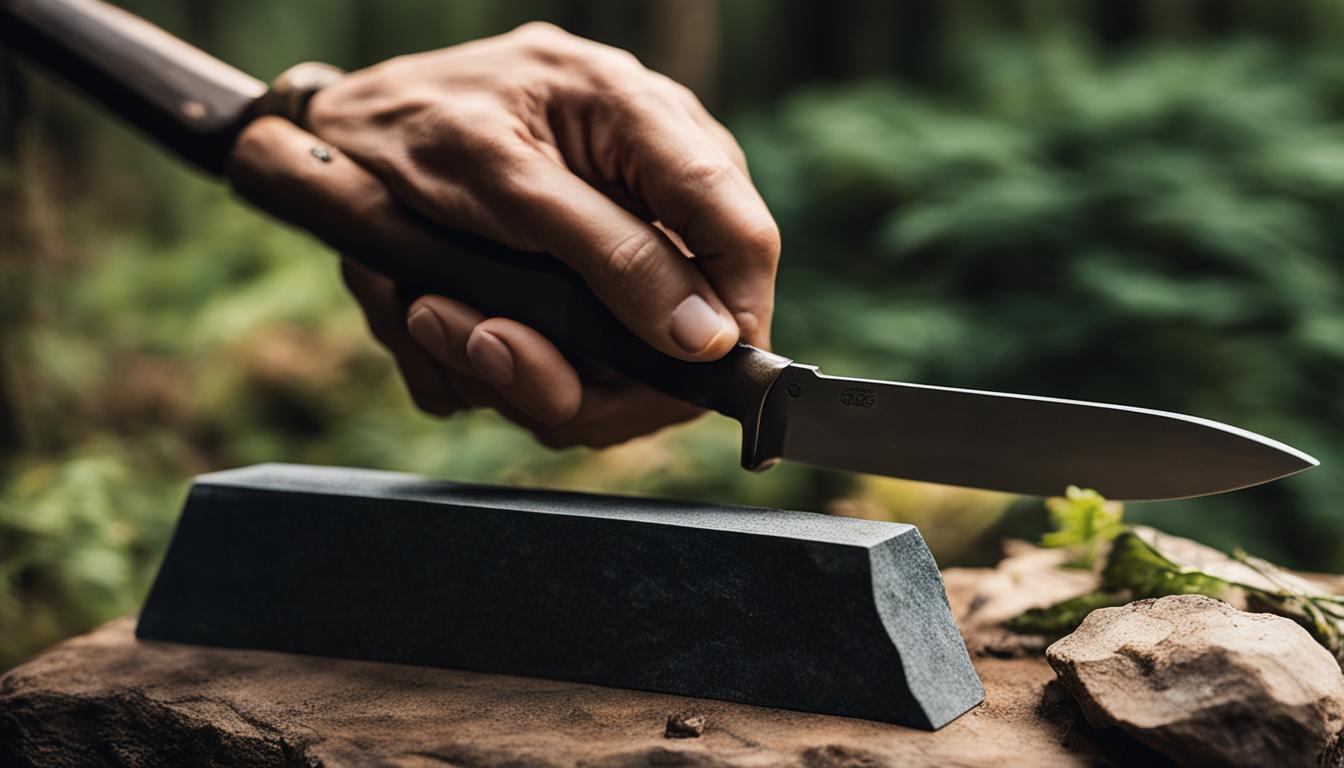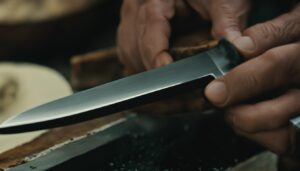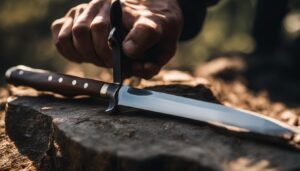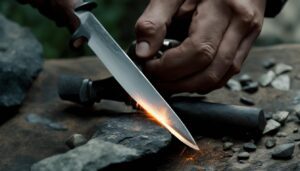Hunting is a passion that demands the best equipment, including a well-maintained hunting knife. In this comprehensive guide, I will provide expert tips and maintenance techniques to ensure your hunting knife stays in top shape. From cleaning and sharpening methods to proper storage and maintenance routines, you’ll learn everything you need to know to maintain your hunting knife like a pro.
Key Takeaways:
- Regularly clean your hunting knife to remove dirt, blood, and debris.
- Keep your knife sharp by using a sharpening stone or sharpening system.
- Proper storage is crucial to protect your hunting knife from rust and damage.
- Additional maintenance tips include lubricating the blade and inspecting for damage.
- Seek advice from experts and reliable resources to enhance your knife maintenance knowledge.
The Importance of Proper Knife Care
Proper knife care is crucial for maintaining the longevity and performance of your hunting blade. Neglecting maintenance can result in dull blades, corrosion, and safety hazards, compromising your hunting experience. By following professional knife upkeep techniques, you can ensure that your hunting knife remains sharp, rust-free, and ready for any adventure.
Regular maintenance is key to preserving your hunting blade’s sharpness. Through consistent cleaning and sharpening, you can maintain the cutting performance of your knife. Additionally, proper storage is essential for protecting your knife from rust, damage, and accidents.
Investing time and effort into maintaining your hunting knife will pay off in the long run. Not only will a well-cared-for knife last longer, but it will also provide reliable performance when you need it most. Keep reading to learn the best practices for cleaning, sharpening, and storing your hunting knife.
The Importance of Regular Cleaning
Regular cleaning is vital to remove dirt, blood, and other debris that may accumulate on your hunting knife. Use mild soap and warm water to clean the blade, making sure to dry it thoroughly afterward to prevent rust. If rust does occur, gently scrub the affected area with a rust eraser or a paste made of baking soda and water. By keeping your knife clean, you not only maintain its appearance but also prevent the buildup of bacteria or odors.
The Significance of Sharpening
A sharp blade is essential for clean and effective cutting while hunting. Regular sharpening will help maintain the cutting performance of your hunting knife. Use a sharpening stone or a sharpening system to hone the edge of the blade, ensuring the correct angle is maintained. Additionally, honing the blade regularly will help preserve its sharpness and prolong the time between sharpenings.
The Importance of Proper Storage
Proper storage is crucial to protect your hunting knife from rust, damage, or accidents. Always clean and dry the blade before storing it to prevent moisture from causing corrosion. Store your knife in a dry place, away from humidity and extreme temperatures. Consider using a sheath or a blade protector to prevent accidental cuts or scratches. By storing your hunting knife correctly, you’ll extend its lifespan and ensure it’s always ready for your next hunting trip.
| Cleaning | Sharpening | Storage |
|---|---|---|
| Regularly clean your hunting knife with mild soap and warm water. | Use a sharpening stone or system to hone the blade and maintain the correct angle. | Store your knife in a dry place, away from humidity and extreme temperatures. |
| Dry the blade thoroughly to prevent rust. | Hone the blade regularly to maintain its sharpness and prolong the time between sharpenings. | Consider using a sheath or blade protector to prevent accidental cuts or scratches. |
The Importance of Proper Knife Care
Proper maintenance is crucial for keeping your hunting knife in top shape and ensuring its longevity. One essential aspect of knife care is regular cleaning. By removing dirt, blood, and other debris that can accumulate on the blade, you not only keep your knife looking its best but also prevent potential damage. To clean your hunting knife, use mild soap and warm water. Gently scrub the blade with a soft brush or cloth, paying close attention to the handle and pivot areas. Rinse the knife thoroughly and dry it completely to prevent rust.
In addition to regular cleaning, it’s important to address rust on your hunting knife promptly. If rust appears on the blade, it can compromise its integrity and performance. To remove rust, prepare a paste using baking soda and water. Apply the paste to the affected area and gently scrub with a soft brush or cloth. Rinse the blade thoroughly and dry it completely. If the rust persists, consider using a rust eraser specifically designed for knives. Regularly inspect your knife for any signs of rust and address it immediately to prevent further damage.
Pro Tip:
“Maintaining a clean and rust-free hunting knife not only enhances its performance but also extends its lifespan. Make it a habit to clean your knife after each use and inspect it regularly for any signs of rust or damage.”
Remember, cleaning and rust removal are essential components of knife maintenance, allowing you to enjoy a reliable and high-performing hunting knife for years to come. By incorporating these practices into your maintenance routine, you can ensure that your hunting knife is always ready for your next outdoor adventure.
| Knife Maintenance Tips |
|---|
| Regularly clean your knife with mild soap and warm water |
| Dry the blade thoroughly to prevent rust |
| Remove rust using a baking soda paste or rust eraser |
| Inspect your knife regularly for signs of rust or damage |
Sharpening Your Hunting Knife
Keeping your hunting knife sharp is vital for optimal performance in the field. A sharp blade not only ensures clean and precise cuts but also reduces the risk of accidents caused by slips or excessive force. In this section, I will outline effective knife sharpening techniques that will help you maintain a razor-sharp edge on your hunting knife.
Choosing the Right Sharpening Tool
There are several options available for sharpening your hunting knife, including sharpening stones, honing rods, and sharpening systems. The choice of tool depends on your preference and comfort level. Whichever tool you choose, ensure that it is suitable for the type of blade you have and consider the angle of the bevel when selecting a sharpening tool.
The Sharpening Process
To begin sharpening your hunting knife, start by securing the blade in a vice grip or holding it firmly against a stable surface. Hold the sharpening tool at the appropriate angle, typically between 15 and 20 degrees, and move it across the blade in a controlled motion. Apply light pressure and maintain consistency in your strokes to achieve an even and sharpened edge.
It’s important to note that different types of blades require different sharpening techniques. For instance, a single bevel blade may require a different angle and approach than a double bevel blade. Consult the manufacturer’s recommendations or seek guidance from experienced hunters or knife enthusiasts to ensure you sharpen your specific type of blade correctly.
Regular Maintenance and Honing
Sharpening your hunting knife should be a regular part of your maintenance routine. However, it’s equally important to hone your knife regularly to maintain its sharpness between sharpenings. Honing involves using a honing rod or a strop to realign the blade’s edge, keeping it straight and sharp. By incorporating both sharpening and honing into your maintenance routine, you can ensure your hunting knife remains in peak condition for all your outdoor adventures.
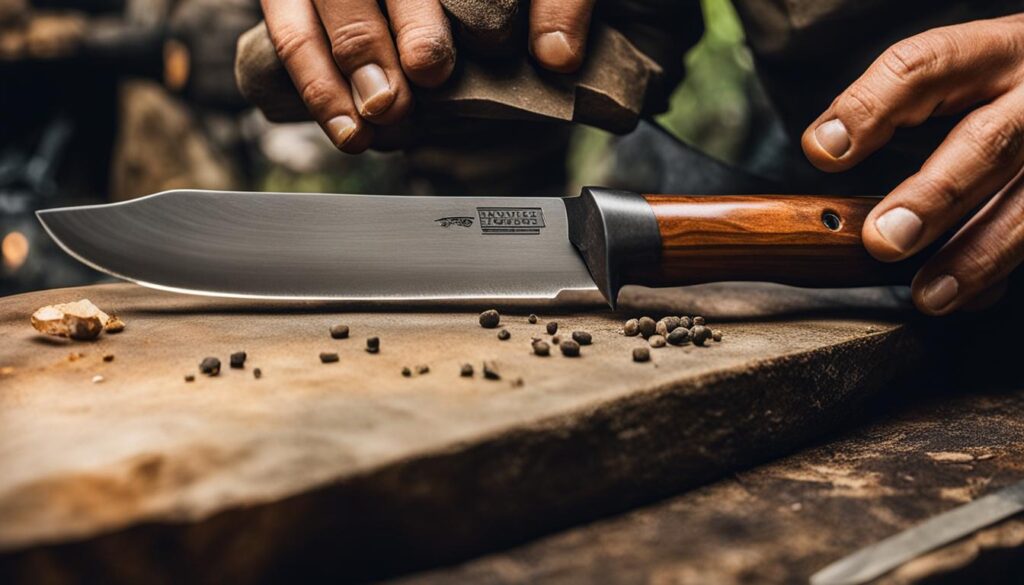
Storing Your Hunting Knife
Proper storage is crucial for protecting your hunting knife and ensuring its longevity. By following these knife storage tips, you can keep your blade in pristine condition and ready for your next hunting adventure.
Best Practices for Knife Storage
- Clean and Dry: Before storing your hunting knife, make sure to clean it thoroughly to remove any dirt, debris, or moisture. Use mild soap and warm water, and dry the blade completely to prevent rust.
- Away from Humidity: Store your knife in a dry place away from high humidity. Moisture can lead to corrosion and damage the blade over time. Consider using a moisture-absorbing silica gel packet in your storage area.
- Temperature Control: Avoid storing your hunting knife in extreme temperatures, as they can affect the blade’s integrity. Opt for room temperature environments to maintain the knife’s performance.
- Sheath or Blade Protector: To prevent accidental cuts or scratches, use a sheath or blade protector when storing your hunting knife. This will also protect the blade’s edge and minimize the risk of damage from coming into contact with other objects.
By following these storage tips, you can prolong the lifespan of your hunting knife and ensure its reliable performance whenever you need it. Remember that a well-maintained knife is a hunter’s best tool.
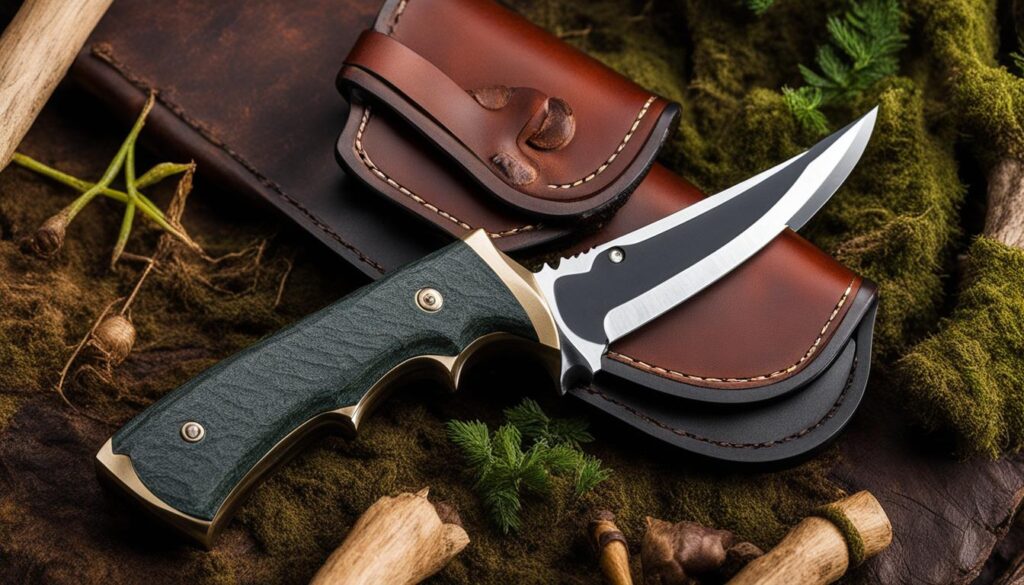

Table: Comparison of Knife Storage Options
| Storage Option | Advantages | Disadvantages |
|---|---|---|
| Sheath |
|
|
| Blade Protector |
|
|
| Display Case |
|
|
Remember to choose the storage option that best suits your needs and the specific conditions of your hunting environment. With proper storage, your hunting knife will remain in optimal condition and ready for action when you need it most.
Hunting Knife Maintenance Tips and Techniques
Proper maintenance is essential for keeping your hunting knife in optimal condition and ensuring its longevity. In addition to regular cleaning, sharpening, and storage, there are other expert maintenance tips and techniques that you can employ to enhance the performance of your hunting knife.
Regular Lubrication with Rust-Preventive Oil
To protect your hunting knife from corrosion and ensure smooth operation, it’s important to regularly lubricate the blade with a rust-preventive oil. Apply a small amount of oil to the blade, pivot points, and lock mechanisms, then wipe off any excess. This will help prevent moisture accumulation and minimize the risk of rust formation, keeping your knife in optimal condition for your hunting adventures.
Checking and Tightening Handle Screws
Over time, the handle screws of your hunting knife may loosen due to repeated use. It’s important to regularly check and tighten these screws to maintain the structural integrity of your knife. Use a suitable screwdriver to tighten the screws, ensuring they’re secure but not overly tightened to avoid damaging the handle material. By regularly inspecting and maintaining the handle screws, you can prevent handle wobbling and ensure a secure grip during hunting activities.
Inspecting for Signs of Damage or Wear
Regularly inspecting your hunting knife for signs of damage or wear is crucial for identifying any potential issues early on. Check for chips, cracks, or deformities in the blade, as well as any loosening or damage to the handle or locking mechanisms. If you notice any problems, it’s best to address them promptly by seeking professional assistance or contacting the knife manufacturer. By proactively inspecting your knife, you can prevent further damage and ensure its optimal performance when you need it most.
By incorporating these expert knife care tips and techniques into your maintenance routine, you can enhance the performance and longevity of your hunting knife. Remember to regularly lubricate the blade, check and tighten handle screws, and inspect for signs of damage or wear. With proper maintenance, your hunting knife will continue to serve you well on your hunting journeys for years to come.
Expert Recommendations and Resources for Hunting Knife Maintenance
When it comes to expert recommendations and resources for hunting knife maintenance, there are several valuable sources you can turn to. Whether you’re looking for tips, techniques, or product recommendations, these resources can help you enhance your maintenance routine and ensure your hunting knife performs at its best.
Reputable Hunting Magazines
Reputable hunting magazines are a goldmine of information when it comes to expert recommendations for hunting knife maintenance. These publications often feature articles written by experienced hunters, knife enthusiasts, and industry professionals who share their insights and techniques. Subscribing to a hunting magazine can provide you with a steady stream of maintenance tips, gear reviews, and comprehensive guides to help you keep your hunting knife in top condition.
Online Forums and Communities
Online forums and communities dedicated to hunting and outdoor activities are another excellent resource for hunting knife maintenance. These platforms allow you to connect with fellow hunters, knife enthusiasts, and experts who are passionate about knife care. You can ask questions, seek advice, and gain valuable insights from the collective knowledge and experiences of the community. Additionally, these forums often have specific threads or sub-forums dedicated to knife maintenance, where you can find detailed tutorials, product recommendations, and discussions on best practices.
Knife Maintenance Guides
There are numerous knife maintenance guides available both online and in print. These guides offer in-depth instructions, step-by-step tutorials, and expert tips on cleaning, sharpening, and storing your hunting knife. Look for guides written by reputable authors, knife makers, or experienced hunters to ensure you’re getting accurate and trustworthy information. These guides can serve as comprehensive resources that cover all aspects of hunting knife maintenance, from basic care routines to advanced techniques.
| Resource | Description |
|---|---|
| Knife Maker Websites | Many professional knife makers have their own websites where they share maintenance tips and techniques. These websites often include detailed guides, FAQs, and even video tutorials to help you properly care for your hunting knife. |
| Hunting and Outdoor Stores | Visiting hunting and outdoor stores can provide you with access to knowledgeable staff who can offer personalized advice on hunting knife maintenance. These stores often carry a wide range of maintenance products and accessories, making it convenient for you to find everything you need in one place. |
| YouTube Channels | YouTube channels dedicated to hunting, survival, and outdoor activities are a great source of visual demonstrations and tutorials on hunting knife maintenance. Many experienced hunters and knife enthusiasts share their expertise through detailed videos that showcase proper techniques and product recommendations. |
By tapping into these expert recommendations and resources, you can continually improve your knowledge and skills in hunting knife maintenance. Utilize the insights and techniques shared by experienced hunters, knife makers, and industry professionals to ensure your hunting knife is always in optimal condition for your next adventure.
Image
Conclusion
In conclusion, expert hunting knife maintenance is essential for optimizing the performance and longevity of your prized hunting tool. By diligently following the tips and techniques outlined in this guide, you can ensure that your hunting knife remains in top shape and ready for your next adventure.
Proper cleaning is key to remove dirt, debris, and potential bacteria from your knife. Regular sharpening will maintain the blade’s cutting efficiency, while proper storage in a dry place will protect it from rust and damage. Additionally, employing additional maintenance techniques like lubrication and regular inspections will further enhance the overall durability and reliability of your hunting knife.
For further guidance, consider consulting reputable hunting magazines, online forums, or visiting hunting and outdoor stores. Experts in the field can provide valuable recommendations and insights to keep you updated on the latest maintenance techniques and products.
Remember, expert hunting knife maintenance is not only about preserving a tool, but also about preserving a passion. By taking care of your hunting knife like a pro, you’ll ensure that it remains a reliable companion on your hunting journeys for years to come.
FAQ
Why is proper knife care important for hunting?
Proper knife care is essential for the longevity and performance of your hunting blade. Neglecting maintenance can lead to dull blades, corrosion, and potential safety hazards. By maintaining your knife diligently, you can ensure it stays sharp, rust-free, and ready for any hunting adventure.
How should I clean my hunting knife?
Use mild soap and warm water to clean the blade, making sure to dry it thoroughly to prevent rust. If rust does occur, gently scrub the affected area with a rust eraser or paste made of baking soda and water. Regular cleaning will not only keep your knife looking its best but also prevent the build-up of bacteria or odors.
How do I sharpen my hunting knife?
Use a sharpening stone or a sharpening system to hone the edge of the blade. Maintain the correct angle while sharpening to achieve a sharp edge. Additionally, honing the blade regularly will help maintain its sharpness and prolong the time between sharpenings.
How should I store my hunting knife?
Always clean and dry the blade before storing it to prevent moisture from causing corrosion. Store your knife in a dry place, away from humidity and extreme temperatures. Consider using a sheath or a blade protector to prevent accidental cuts or scratches.
Are there any additional tips for maintaining my hunting knife?
Yes, you can lubricate the blade with a rust-preventive oil, check and tighten the handle screws regularly, inspect the blade for any signs of damage or wear, and avoid using your knife for tasks it’s not designed for. By following these additional maintenance tips, you can enhance the longevity and performance of your hunting knife.
Where can I find expert recommendations for hunting knife maintenance?
Consult reputable hunting magazines, online forums, and knife maintenance guides for valuable insights and recommendations. You can also reach out to professional knife makers or visit hunting and outdoor stores for personalized advice.
